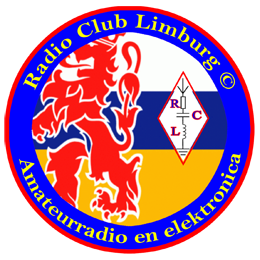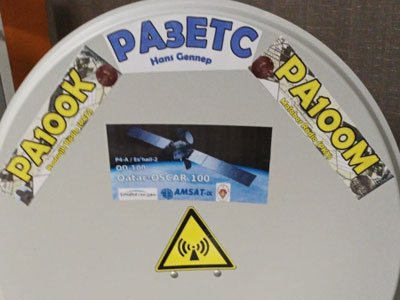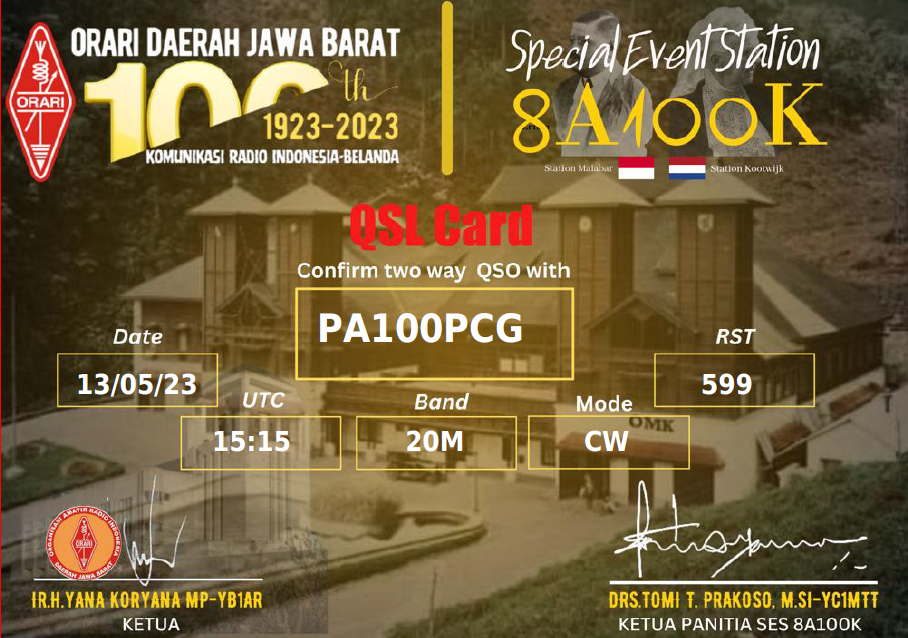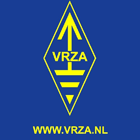About The stations PA100M and PA100K
Hello visitor from
Celebrating world radio history, bridging 100 years from 1923 to 2023. Powered by members of RCL | Radio Club Limburg.
Two historic radiostations and their corresponding reception stations, at the time referred to as PKX (Malabar, Indonesia) and PCG (Kootwijk, The Netherlands), pioneers in the field of long-range long-wave telegraphic communication. And now two special event stations celebrating 100 years of radiocommunication history between Indonesia and The Netherlands.
After 100 years we are honoring in 2023 Malabar Radio with amateur radio station PA100M and Kootwijk Radio with amateur radio station PA100K.
When
The two special events stations PA100M and PA100K will be active during the year from Friday 5 May 2023 untill the end of June 2023.
From Friday 5 May 2023 up to Sunday 7 May 2023, the Special Event Stations will be open to visitors, each day from 10:00 hrs to 17:00 hrs and on Sunday to 15:00 hrs.
You can watch and listen to how short-wave communication still is made worldwide in the traditional way in telegraphy (morse) - as was the case in the past - and also telephony (speech). Demonstrations are also given on how to make connections via satellites using satellite equipment.
Where
During the three visitor opening days from our location at Stevensbeek, the former location of the first Dutch reception station from 1919 up to 1924, The Netherlands.
Address:
Radioweg 11, 5844 AA Stevensbeek.
Click here to find our visitors location on the map.
With orari and the heritage society
Radio Club Limburg will work closely together with Orari and the Heritage Society Stevensbeek.
Orari
 On Saturday 6 May 2023 the official opening ceremony will take place in CW. At 15:15 hrs local Dutch time (13:15 UTC) telegrams are received and sent from
Stevensbeek - as happened 100 years ago - to and from Indonesia along with Indonesian Special Event Station 8A100K of Orari in Indonesia. On Sunday 7 May 2023 a QSO ceremony will take place in SSB with 8A100K at 15:15 hrs local Dutch time (13:15 UTC).
On Saturday 6 May 2023 the official opening ceremony will take place in CW. At 15:15 hrs local Dutch time (13:15 UTC) telegrams are received and sent from
Stevensbeek - as happened 100 years ago - to and from Indonesia along with Indonesian Special Event Station 8A100K of Orari in Indonesia. On Sunday 7 May 2023 a QSO ceremony will take place in SSB with 8A100K at 15:15 hrs local Dutch time (13:15 UTC).
Heemkundekring Stevensbeek
Members of the Heritage Society Stevensbeek will be present during the visitor days from Friday 5 May 2023 up to Sunday 7 May 2023.
Limited information is available on the Internet about the Sambeek reception station. The station has only been there for 5 years. The Heritage Society Stevensbeek has a wealth of information about the station in its archives. They will use presentations and displays to show the visual material they have present - and tell stories about - the former reception station at Sambeek.
Three major events in 2023: PA100M/PA100K, PA100PCG and 8A100K
Three major anniversary events in 2023.
In The Netherlands the VRZA project ´PA100PCG´ and the Radio Club Limburg project ´PA100M/PA100K´.
In Indonesia the national radio society Orari will activate Special Event Station 8A100K.
All radio organisations work closely together and share their activities, websites and other resources.
Award to get for radio amateurs
The four Special Event Stations PA100M, PA100K, PA100PCG and 8A100K are valid for an award. At the QSL/Award chapter you can read how to get this award.
History
The history of the TX and RX stations in brief
Preface
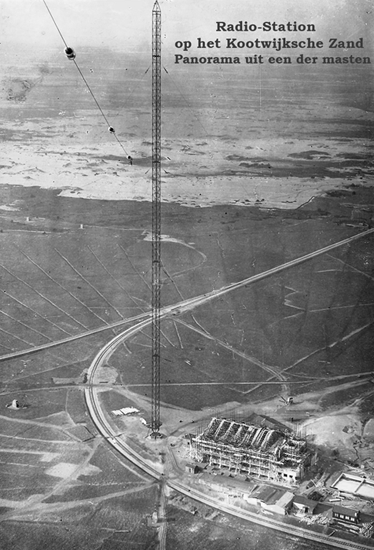 At the beginning of the twentieth century, The Netherlands was dependent on an English cable connection for telegraphic communication with Indonesia (former The Dutch East Indies).
During the Second Boer War in South Africa (1899-1902), the British government exercised such severe censorship on telegraphic communications that an alternative was sought in The Netherlands.
An agreement was then concluded with Germany. In 1905, the ´Deutsch-Niederländische Telegraphen Gesellschaft´ was founded in Cologne and operated the
Menado–Yap–Guam cable. This cable connected to an American cable from the Philippines to the United States, which was operated by the American Commercial Cable Company.
It soon became apparent that this company had close relations with the British company, so this was not a real option in the end.
At the beginning of the twentieth century, The Netherlands was dependent on an English cable connection for telegraphic communication with Indonesia (former The Dutch East Indies).
During the Second Boer War in South Africa (1899-1902), the British government exercised such severe censorship on telegraphic communications that an alternative was sought in The Netherlands.
An agreement was then concluded with Germany. In 1905, the ´Deutsch-Niederländische Telegraphen Gesellschaft´ was founded in Cologne and operated the
Menado–Yap–Guam cable. This cable connected to an American cable from the Philippines to the United States, which was operated by the American Commercial Cable Company.
It soon became apparent that this company had close relations with the British company, so this was not a real option in the end.About 1913, two plans for a wireless connection with Indonesia were submitted in The Netherlands. One plan envisaged a connection via intermediate stations in Tripolis, Massovah and in Sri Lanka (former Ceylon) depending on the cooperation of Italy and (again) England. The other plan envisaged a connection through the West Indies, Hawaii and the Samoa Islands. The commission granted a concession for the first plan, but this plan was covered up. Opposition mainly came from the Minister of Colonies and the Minister of Water Management. The latter stated that he wanted to let the matter rest pending the tests that the Dutch government wanted to take in the field of radiotelegraphy in Indonesia. Both the Marconi Company and Telefunken were to be invited for these trials. Shortly afterwards, the First World War broke out.
The disadvantages of being dependent on foreign connections were again very noticeable, especially when the German submarine cable with which the coded telegraphic communication between The Netherlands and Indonesia was maintained, was destroyed. Indonesia was now only accessible via British cables and that meant a ban on the use of code words and it meant censorship and huge delays. In 1917, Captain-Lieutenant Commander E.H. Friderichs, chief of naval wireless telegraphy, urged the Permanent Commission to speed up a wireless connection with Indonesia. He proposed to build a powerful transmitting station within the Defence line of Amsterdam, for the time being only for political and military purposes. This proposal also proved to be unsuccessful.
Malabar Radio (PKX) - transmitter site

The call for a wireless connection to Indonesia grew louder and louder. In response to this, shortly after the end of the First World War, the Dutch Government reported from Jakarta (former Batavia) they had started building a wireless telegraphy radiostation that could communicate directly with the radiostation in The Netherlands (PCG). Building the Long Wave Radiostation Malabar, or ´the Gouvernements Zendstation Malabar´, in Malabar near Bandoeng (Java, Indonesia) started in the year 1917. Dr. ir. C.J. de Groot designed a 2.4 MW long wave spark-gap transmitter, the original Poulsen arc transmitter design accordingly and about 60 - 80% of its power into the antenna. It took about 2 years to build the station. The long wave antenna was mounted in the Malabar gorge. The newly constructed antenna also had tremendous dimensions (see the pictures above and below). The large long-wave antenna was supported by 5 inch steel cables stretched over the gorge of some 2.000 meters. The suspension points on the two foothills of the Gunung Malabar were located about 900 meters above the station.
 Five motor-driven winches on the south side, and corresponding counterweight conditions on the north side, served to keep the tensile stress of 10.000 kg constant.
Five motor-driven winches on the south side, and corresponding counterweight conditions on the north side, served to keep the tensile stress of 10.000 kg constant.
The actual antenna wires consisted of copper wire wrapped non-ferrous carrier material of 7/8 inch strength. Due to the large surface area achieved in this way, Corona effects were encountered. The attachment to the carrier cable took place at a height of 700 meters by means of 2 meter long insulators. The drawings show that roughly the eastern antenna cross-lines, which carried the antenna, were mounted at the slope of mount Gunung Poentang, and the western lines were anchored at the slope of mount Gunung Haroeman. The parallel antenna wires in the gorge started at 246 meters above the Malabar station level and sloping up to 715 meters. The station itself was at a level of 1.250 meters ASL.
Most probably the gorge did not give the antenna much directivity, as its length was too short in respect to the transmitter maximum wavelength (λ) of 18.75 km! Its main function was to create a capacitance against ground.
 On May 5th 1923 the Malabar Station (PKX) was officially opened sending a telegram of congratulations to Her Majesty The Queen in The Netherlands. The picture on the right.
On May 5th 1923 the Malabar Station (PKX) was officially opened sending a telegram of congratulations to Her Majesty The Queen in The Netherlands. The picture on the right.The location of the Malabar Station near Bandoeng was obvious; Bandoeng was the political-strategic centre of Indonesia at those days. Since Dr. ir. De Groot did not have masts of sufficient height, he came up with the idea install the antenna in a mountain gorge on the Malabar, a plateau near Bandoeng. In this way a height was reached that even surpassed the Eiffel Tower, the highest radio mast in the world at that time. The arc transmitter was connected to this antenna.
 When the transmitting station took on a more final character, a new building was erected. The picture on the left. It became a mixture of the typical indigenous construction and the Dutch variant of the ´decorated shed´.
Despite the simplicity of the construction, the building had unmistakably monumental features, which were due to the symmetrical structure with a double tower on both the left and right and a
cooling water pond in the axis of the whole. If we now know that one tower contained the 400kW Telefunken transmitter, the other the giant 2.4 MW arc transmitter, it seemed that this
architecture embodied the triumph of Dr. ir. De Groot by demonstrating the equality of both transmitters.
When the transmitting station took on a more final character, a new building was erected. The picture on the left. It became a mixture of the typical indigenous construction and the Dutch variant of the ´decorated shed´.
Despite the simplicity of the construction, the building had unmistakably monumental features, which were due to the symmetrical structure with a double tower on both the left and right and a
cooling water pond in the axis of the whole. If we now know that one tower contained the 400kW Telefunken transmitter, the other the giant 2.4 MW arc transmitter, it seemed that this
architecture embodied the triumph of Dr. ir. De Groot by demonstrating the equality of both transmitters.In that first year, no fewer than 3.413 QSO´s took place between The Netherlands and Indonesia. The Indies- and Dutch Radio Services were therefore justifiably proud of this longest direct telegraph connection in the world. A new way to Indonesia had been opened. The stations proved to be the most important connection between The Netherlands and Indonesia during the Interbellum. But the enormous resources required to send telegrams were actually disproportionate to the achievement.
"Special Event Stations PA100M and PA100K"A few years earlier, in 1920, a few radio amateurs, who had been pushed to ever shorter waves by the growing number of official transmitters, had discovered that with relatively little transmitting energy at wavelengths of 200 meters and higher (short-wave) one could bridge enormous distances. These radio waves had the nice property that they lost relatively little energy during their journey through the air. Moreover, these frequencies were much less affected by the noisy atmospheric disturbances that so often drowned out the long-wave radio signals. However, the professional radioworld ignored this fact and stubbornly stuck to the generally accepted theory that only long-waves were suitable for reliable long-distance traffic. But more and more publications about record connections appeared in radiomagazines. In 1925 a short-wave transmitter was built more or less unofficially in the PTT Laboratory on Parkstraat in The Hague. This transmitter operated on a 42 meter wavelength and had a power of only a few hundred watts (a fraction of the 2.4 MW in Malabar and the 400 kW station in Kootwijk). An aerial wire had been stretched from the laboratory attic to a nearby churchtower. The days after the first trial broadcast, a reception report arrived from Indonesia. The transmitter was heard loud and clear. But here too, Indonesia had already been ahead of The Netherlands by six months. The transmitter ANE, which was broadcasting from the Malabar, was already working regularly with stations at a great distance on a wavelength of 85 meters. On August 7th, 1925, a connection was established on the shortwave and 500 words were telegraphed that same evening.
 The fate of the longwave transmitters was thus sealed.
A better result was achieved with equipment that fit on a table top than with the Malabar giant. Now radiotraffic between the Netherlands and Indonesia could really start.
After all, it was now possible to maintain a connection 24-hours a day instead of the few nighttime hours that were possible with the long-wave transmitter. Technology made more and more possible.
From January 7th, 1929, the public could also telephone via the radiolink between The Netherlands and Indonesia. And it was a huge success, despite the fact that a conversation of a
few minutes cost almost half a week´s average wage.
The fate of the longwave transmitters was thus sealed.
A better result was achieved with equipment that fit on a table top than with the Malabar giant. Now radiotraffic between the Netherlands and Indonesia could really start.
After all, it was now possible to maintain a connection 24-hours a day instead of the few nighttime hours that were possible with the long-wave transmitter. Technology made more and more possible.
From January 7th, 1929, the public could also telephone via the radiolink between The Netherlands and Indonesia. And it was a huge success, despite the fact that a conversation of a
few minutes cost almost half a week´s average wage.The Malabar station - in the end - was part of a larger network of radiotransmitting- and radioreception sites in the Bandung region, first on long-wave and later on short-wave. Reception stations were built at Padelarang, Ranca-Ekek and Cangkring. Other transmitter sites were located at Cililin and Dajeuhkolot. Furthermore there was an antenna teststation at Cimindi (picture on the left) and two radiolaboratories in and near Bandung.
In 1947, just after the second world war, the fate of many of these station was sealed and many stations completely destroyed. Today, only ruins remains of the Malabar station. A closer look on the map reveals the original cooling water pond.
Malabar Radio (PKX) - reception station at rancaekek

The first reception station for duplex operation along with the transmitter in Malabar was set up at a short distance from Malabar in Cangkring (Tjankring in the picture). At the Cangkring reception station a Telefunken loop antenna of 100 m2 was used, which encountered relatively much interference. This can partly be explained by the relatively short distance to the very strong Malabar transmitters. The distance was only 13 km. Once it was decided to move the reception station at Cangkring - as far as our knowledge reaches - reception tests were conducted in many places, both near the coast and inland. Because the coastal locations did not produce better results than those at greater distances from the coast, two places on the Bandung Plateau were selected for conducting more extensive tests: a site in the vicinity of the dessa Rancaekek (Rantja Ekek in the picture) and near Padalarang. Rancaekek was in a straight line about 18 km from Bandung in a south-eastern direction. Padalarang was located on the other side of Bandung in the North West.
The distance from both locations to the transmitting station at Malabar became larger compared to the Cangkring location. According to Klaas Dijkstra's book Radio Malabar, the distances of both stations to Malabar would be approximately 40 km to Malabar, but based on distance measurements on Google Maps, these distances seem considerably shorter, especially the distance from Rancaekek to Malabar. When choosing the locations Padalarang and Rancaekek, their strategic value was also explicitly taken into account. It was considered important for various reasons that the main radiostations should possibly be kept within the Bandung (military) position.

During the reception tests at Rancaekek, a smaller Telefunken loop antenna of 10 m2 was used, which antenna performed better than the large loop antenna at Cangkring, as it was less affected by the strong Malabar transmitter. As a receiver, a Telefunken radiodevice was used, which had high- and midfrequent amplification. In contrast to Cangkring, where all the devices were put together in one metal enclosure, at the test stations all devices were mounted in separate metal enclosures. As long as Cangkring was still in operation and the company headquarters was also located there, the received signals were also transmitted to this station by cable. This made it possible to work out with a minimum of staff.
When the company headquarters was moved to Bandung at the end of 1924, this mode of operation was not only maintained, but Cangkring also passed on the received telegrams. A few months later, in May 1925, the company headquarters moved again, this time to Indonesia's largest telegraph center, ´Batavia Centre´. As a result, the back and forth of telegrams between Batavia and Bandung was no longer necessary, which shortened the transit time of messages again.
Since the site in the vicinity of Rancaekek turned out to be very suitable for setting up a reception station, this place was finally chosen. At the beginning of 1925 the reception station at Cangkring was disbanded and when Rancaekek was fully functional, Padalarang was also disbanded after having served for about a year and a half. The area around Rancakek was quite different, than Cangkring's. The latter was in hilly terrain, on Rancaekek it was completely flat. The nearest mountain range was a few kilometers away.

The entire area around Rancaekek consisted of sawah and was very rich in water. Rice was cultivated here from November to June. At that time, the groundwater was only 0.25 meters high. Even during the dry season between June and October, this groundwater in the fatty clay soil did not sink deeper than one meter. This factor was perhaps not unfavorable for the location of a receiving station.
If there was only one single building at Cangkring, in which everything was housed, several buildings were erected at Rancaekek, based on previous experiences. For example, the dynamos for the generation of direct current (DC) with the accumulator batteries had a separate building, which was placed about 100 meters from the actual reception building. As a result, it was hoped that there would be less trouble with sparking brushes and other malfunctions. Telefunken's 10 m2 reception loop - the large loop in Cangkring was no longer installed after the move - also received a separate turret, which was separated from the other buildings.
Soon after the Rancaekek reception station was put into operation, it became apparent that Malabar's large 2.4 MW arc transmitter was also interfering there. On one hand, this was due to the gradual increase in the power of this transmitter and on the other hand through increasingly better reception techniques at Rancaekek. Malabar's interference at the first reception station at Cangkring had been the very reason for moving to a new location. This was a setback and moving the new station again to yet another was no longer an option.
 Employee C. de Haas eventually succeeded in achieving interference-free reception. By coupling two types of antennas together, a receiving characteristic was obtained, that had a heart shape. If the antennas were
properly arranged and directed so that Malabar was on the side of the minimum reception strength and Europe on that of the maximum, the disturbing influence was reduced to a minimum,
while the reception of the European signals were interference-free.
Employee C. de Haas eventually succeeded in achieving interference-free reception. By coupling two types of antennas together, a receiving characteristic was obtained, that had a heart shape. If the antennas were
properly arranged and directed so that Malabar was on the side of the minimum reception strength and Europe on that of the maximum, the disturbing influence was reduced to a minimum,
while the reception of the European signals were interference-free.
Kootwijk Radio (PCG) - transmitter site
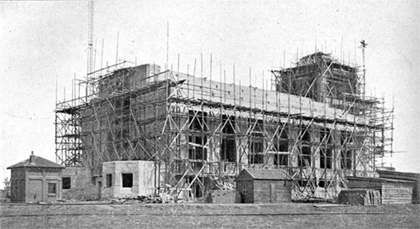 After much political discussion, it was finally decided in 1918 to build a transmission station for the long-wave, for which a suitable location was found on the sand drifts near the village of
Kootwijk.
After much political discussion, it was finally decided in 1918 to build a transmission station for the long-wave, for which a suitable location was found on the sand drifts near the village of
Kootwijk. In the winter of 1918 about 150 excavation workers from Amsterdam started preparing an area of 450 ha on the Kootwijkerzand under supervision of The Dutch company Heidemij for the construction of
a long-wave telegraphy station for communication between The Netherlands and Indonesia (former The Dutch East Indies). The masts were ordered in Germany in september 1918 since there was no such supplier
to be found in The Netherlands. About 380.000 cubical metres had to be moved to lay out and level the site. After completion of the ground works a narrow gauge railway was constructed for the supply
of building materials, tools and steel for the antenna masts. Six large lattice masts of each 211.6 metres were erected for supporting the long-wave antenna, together with the construction of the main
Building A for the long-wave station with its transmitters. The weight of each mast was 80.000 kg and each side was 3.50 metres wide. Each mast balanced on one point on a ball joint being isolated
from ground. Each mast was kept in place with isolated guy wires each at a distance of 48 meters on the mast. All the masts were placed at distances of 450 meters.
In the winter of 1918 about 150 excavation workers from Amsterdam started preparing an area of 450 ha on the Kootwijkerzand under supervision of The Dutch company Heidemij for the construction of
a long-wave telegraphy station for communication between The Netherlands and Indonesia (former The Dutch East Indies). The masts were ordered in Germany in september 1918 since there was no such supplier
to be found in The Netherlands. About 380.000 cubical metres had to be moved to lay out and level the site. After completion of the ground works a narrow gauge railway was constructed for the supply
of building materials, tools and steel for the antenna masts. Six large lattice masts of each 211.6 metres were erected for supporting the long-wave antenna, together with the construction of the main
Building A for the long-wave station with its transmitters. The weight of each mast was 80.000 kg and each side was 3.50 metres wide. Each mast balanced on one point on a ball joint being isolated
from ground. Each mast was kept in place with isolated guy wires each at a distance of 48 meters on the mast. All the masts were placed at distances of 450 meters.
 The six lattice masts carried an long-wave umbrella antenna. Inside the main Building A two Telefunken machine transmitters of each 400 kW were to be set up.
The six lattice masts carried an long-wave umbrella antenna. Inside the main Building A two Telefunken machine transmitters of each 400 kW were to be set up. In the years before 1925, the general opinion was that large distances could only be bridged by radio on very long-waves, such as wavelengths of several tens of kilometers. This required powers of
hundreds of kilowatts and two methods were known to generate this: the arc transmitter and the machinetransmitter. The transmitter in Kootwijk was of the latter type. For the powersupply a
high-voltage line was laid to Kootwijk from a PGEM substation near Apeldoorn.
At the completion of the main radio Building A and the cooling water pond, other annexes, (service)buildings, a 50kV high voltage
switching station, transformers houses, a watertower, a hotel and the village radio Kootwijk were built.
In the years before 1925, the general opinion was that large distances could only be bridged by radio on very long-waves, such as wavelengths of several tens of kilometers. This required powers of
hundreds of kilowatts and two methods were known to generate this: the arc transmitter and the machinetransmitter. The transmitter in Kootwijk was of the latter type. For the powersupply a
high-voltage line was laid to Kootwijk from a PGEM substation near Apeldoorn.
At the completion of the main radio Building A and the cooling water pond, other annexes, (service)buildings, a 50kV high voltage
switching station, transformers houses, a watertower, a hotel and the village radio Kootwijk were built.On Thursday, January 18th 1923, the transmitter was heard for the first time in Indonesia. PCG officially entered service on May 5th 1923.
The results were disappointing. The transmittingstation in Kootwijk and receptionstation in Sambeek (near Boxmeer) involved a large investment for that time. But the results, measured by the number of telegrams transmitted, were disappointing. As already mentioned, the transmitter officially went into operation in 1923. A historic moment in Dutch radio history, because the distance between The Netherlands and Indonesia of 11.410 km was bridged on both sides. But why it didn´t work out? The connection was only possible when the entire radio path was in the dark; in The Netherlands between about 5 and 11 p.m. Moreover, the telegraph operators in Indonesia in particular were plagued by the heavy thunderstorm disturbances at low frequencies in tropical areas. As a result, and partly due to the ´lumpy´ signaling system used and the small bandwidth of the transmitting antenna, it was only possible to signal slowly.
 No more than 500 to 1.000 words were sent each evening. But the main reason for the very limited success was competition from short-wave, whose good long-distance capabilities were
´discovered´ just before PCG entered into service.
No more than 500 to 1.000 words were sent each evening. But the main reason for the very limited success was competition from short-wave, whose good long-distance capabilities were
´discovered´ just before PCG entered into service.From 1923 to 1925 the station was on the air on long-wave (radiotelegraphy) and test were executed on short-wave (radiotelephony). See the picture on the right for short-wave building C, D and E and a selection of the short-wave antennas. The long-wave station existed until the Second World War, and was used on short-wave until 1998 for radiotelegraphy, radiotelephony and telex. Scheveningen Radio (PCH) had also started using the facilities from 1968 to 1998 for radiotelegraphy, radiotelephony and UPI telex.
The longwave transmitter PCG (or ´Lange Gerrit´ as it was called by the staff) existed until the Second World War as stated before. The Germans blew up the station and it led to the of end a special chapter of Dutch radio history. Kootwijk Radio was ´silent key´. Two lattice masts were rebuilt after the war from the remains of the six also blown up lattice masts. The two masts served as support masts for other antennas. Today none of these masts exist anymore.
The most striking and largest building, Building A, has the status of a national monument today. The same applies to the watertower, several electricity pylons, the kV station and the transmitter buildings C, D and E.
Kootwijk Radio (PCG) - reception station at sambeek
 To prevent direct interference - to be caused by the Kootwijk transmitter with its huge power of 400 kW - on the signals received in The Netherlands during duplex operation, the receiver had to be put on another location far away from the transmitter. Besides the interference issue, the basic electrical design for the transmitter antenna differed from the design of the reception antenna. This was another reason to have a seperate reception station. Duplex operation was an important condition: as there was a limited (time)window of operation between The Netherlands and Indonesia time had to be used effectively and the arc and machine transmitters would be in operation more regularly.
To prevent direct interference - to be caused by the Kootwijk transmitter with its huge power of 400 kW - on the signals received in The Netherlands during duplex operation, the receiver had to be put on another location far away from the transmitter. Besides the interference issue, the basic electrical design for the transmitter antenna differed from the design of the reception antenna. This was another reason to have a seperate reception station. Duplex operation was an important condition: as there was a limited (time)window of operation between The Netherlands and Indonesia time had to be used effectively and the arc and machine transmitters would be in operation more regularly.
For Kootwijk Radio the first location for a reception station was found on the heath of the small town of Sambeek, south of the city of Boxmeer. A reception station was set up near ´the Radio forest´, as we know it today. In those days the transmitting and receiving stations had to be apart no less than 50 kilometers, as the weaks signals from Malabar easily could be interfered by the strong Kootwijk transmitter signals. Furthermore, the direction of Sambeek was decisive for the choice of location. The direction of the reception station for Kootwijk had to be perpendicular to the direction of the signal path Kootwijk-Malabar. Sambeek complied with this and construction started in 1919 and finished november 1919.
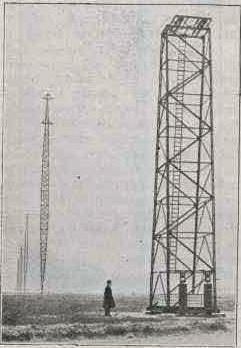 Seven wooden masts in one straight line, each 61.5 meters tall, were erected, to carry the antennas. The antennas consisted of three horizontal antennas, all three with different lengths. Instead of using earth as a counter-capacity, open dipole antennas were used.
The wooden reception building was situated in the very center of the antennas and was fed by symmetrical feedline from the apex of each dipole antenna. At a level of 60 meters a dipole antenna of 2* 900 meters was hung, a dipole antenna of 2* 675 meters at 45 meters and a dipole antenna of 2* 350 meters at 24 meters.
The two longest dipoles were kept in place in a straight line and held under tension by means of counterpoises that were hung in a guyed mast. The smallest dipole was kept in place by guy wires leading to the second respectively fifth mast.
Seven wooden masts in one straight line, each 61.5 meters tall, were erected, to carry the antennas. The antennas consisted of three horizontal antennas, all three with different lengths. Instead of using earth as a counter-capacity, open dipole antennas were used.
The wooden reception building was situated in the very center of the antennas and was fed by symmetrical feedline from the apex of each dipole antenna. At a level of 60 meters a dipole antenna of 2* 900 meters was hung, a dipole antenna of 2* 675 meters at 45 meters and a dipole antenna of 2* 350 meters at 24 meters.
The two longest dipoles were kept in place in a straight line and held under tension by means of counterpoises that were hung in a guyed mast. The smallest dipole was kept in place by guy wires leading to the second respectively fifth mast. 
A antenna-input and -switchboard was used to choose the right antenna for the right moment to connect to one of the two present receivers. Sometimes ´odd´ antenna combinations were used to get the best reception and the least interference: using only one side of the antenna and the other side to earth or a combination of a long leg and a shorter leg at the counter side. The antenna-switchboard also consisted of two chokes for each leg dissipating static charges to earth without influencing the reception. The technical equipment was mainly provided by the German Telefunken company, comprising tuning units, detector- and (high and low frequent) amplifier units, replacable coil and capacitor units. Reception was based on the zero-beat principle (BFO).
At the end of 1919 after completion of the station, signals were first received in Sambeek from Malabar, four years before both transmitting stations were officially opened. The completion of the reception station in Sambeek was way ahead of the transmitting station in Kootwijk. More (technical) information about the reception station at Sambeek can be found here: Magazine Engineer, 6 March 1920: The National-radio-reception station at Sambeek (in Dutch).
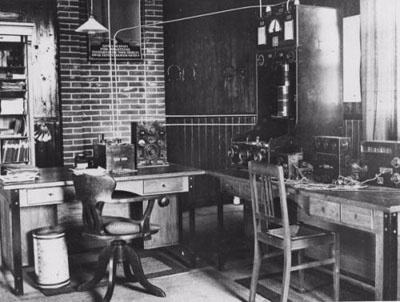 The complex and striking installation, certainly for that time, has been on the Sambeek heath for only five years from 1919 untill 1924. The reception station performed excellent, but the processing of the received telegrams from Malabar was too slow: the central telegraph office was located in Amsterdam and Sambeek was out of the direction. Messages received in Sambeek had to be retransmitted again, now to Amsterdam, which was quite cumbersome.
In 1924 another station was put into operation, which was closer to Amsterdam and had a cable connection to Amsterdam. That is why the reception station moved to Wassenaar (the Meyendel estate) and eventually to Nederhorst den Berg.
The complex and striking installation, certainly for that time, has been on the Sambeek heath for only five years from 1919 untill 1924. The reception station performed excellent, but the processing of the received telegrams from Malabar was too slow: the central telegraph office was located in Amsterdam and Sambeek was out of the direction. Messages received in Sambeek had to be retransmitted again, now to Amsterdam, which was quite cumbersome.
In 1924 another station was put into operation, which was closer to Amsterdam and had a cable connection to Amsterdam. That is why the reception station moved to Wassenaar (the Meyendel estate) and eventually to Nederhorst den Berg.
In 1925 the wooden masts were sold for a fraction of the initial investment. A compensation for the early termination of the leasecontract had to be paid to the municipality of Sambeek. The wooden houses and buildings became the property of the municipality. The 4.600 meter long Radioweg came back into the ownership and maintenance of the municipality on April 1, 1926. The concrete foundations of the buildings have remained in the ground of the forest around the ´Radiolake´ to this day. One of the tension masts served for years as a watchtower in the surrounding forests for the Dutch State Forestry Service. The radio buildings have disappeared over time.
Locations of the two historic TX and RX stations
Use the radiobuttons in the box to change the Map Layers and toggle the visibility of the Locations, Signal-path and Antennas. To see the configuration and actual sizes of the former antennas at Malabar Radio and Kootwijk Radio and the antennas of their corresponding reception stations, click the Zoom in to buttons to actually zoom in. Clicking the respective
 buttons allows you to Zoom in to the station locations with Google Earth (when installed on your computer).
buttons allows you to Zoom in to the station locations with Google Earth (when installed on your computer).
Source references
All content with the kind written permission of:
Jan-Willem Udo (PA0JWU), www.radiokootwijk.nu
Arthur O. Bauer (PA0AOB), www.cdvandt.org/dutch-indies-ptt.htm
So much more to discover about Malabar Radio and Kootwijk Radio on the above persons respective websites (click).
Furthermore worthwhile reading and viewing:
About Kootwijk
Tussen zand en zenders (in Dutch)
Radio Kootwijk: de wereld rondom een zendstation (In Dutch)
Wij schakelen over op den versterkten zender (in Dutch)
Technische beschrijving van het station te Kootwijk (in Dutch)
Rijkszendstation Kootwijk Radio (in Dutch)
De radiotelefonieverbinding tussen Nederland en Indië (in Dutch)
About Sambeek
Magazine Engineer, 6 March 1920: The National-radio-receptionstation at Sambeek (in Dutch)
Radio News, 1 August 1921: the rotatable loop at Sambeek (in Dutch)
Radio News, 1 December 1923: the reception equipment at Sambeek
About Malabar
Radio Malabar, deel I (in Dutch)
Radio Malabar, deel II (in Dutch)
Arthur Bauer (PA0AOB): videopresentation of the Malabar station of Dr.ir. De Groot
90 jaar radio Malabar - eerste radiotelegrafie-verbinding (in Dutch)
Unieke foto´s van zendstation Malabar (in Dutch)
Wat is er nog over van de installaties in Bandoeng (in Dutch)
CQ DL Magazine 7-2022: Die Funkstation Malabar (in German)
Both Malabar and Kootwijk
Louis Meulstee (PA0PCR), Fixed Service Radio in The Netherlands
Huib Ekkelenkamp, Koninklijk Instituut Van Ingenieurs (in Dutch)
Electron September 2017: a century radio-pioneering (in Dutch)
Van Alphen: 25 years radiotraffic services (in Dutch)
Hoogland: over and out (in Dutch)
Brink and Schell: history of the State Telegraph - from page 192 onwards (in Dutch)
PT: The radio link Netherlands - Dutch-Indies (in Dutch)
Radio News, 1 June 1923: the radio service Netherlands - Dutch-Indies opened (in Dutch)
Station
Operators and station descriptions
our operators and support group

PA0Q (Hans)

PF5X (Enno)

PA0BWL (Wil)

PA3ADJ (Stefan)

PA4A (Andrzej)

PA2P (Jan)

PA1K (Bert)

PG3N (Peter)


PA3ETC (Hans)

PD8RW (Roy)

DL4BER (Ber)

PA3FQK (Mark)

PD2LEO (Leo)

PA3EFR (Erwin)

PD9HIX (Sander)

PE1MR (Michel)

PE2PVD (Patrick)

PE1WVD (Wim)


PA2D (Ger)

Milco

PE1NIB (Chris)
Station description
PA100K
PA100M


Transceivers
Kenwood TS590-SG (2x)
MicroHam Keyer (2x)
solid state HF PA (2x)
bandpass filters (5x)
home brew satellite TRX
Antennas
4 el Nagara beam yagi 3 bands 20/15/10M
vertical Cushcraft 5 bands 20-10M
monoband vertical 30M
monoband vertical 40M
monoband dipole 80M
satellite dish
Automation
HP laptop
N1MM logging software
HP laptop
N1MM logging software
Panorama radio building (main room)
Navigate through the room with the mouse on the panorama image, or navigate by moving the field of view on the floorplan with the mouse. Zoom in and out by moving the green dot at the bottom of the panorama image on the slider.
QSL, Logbook and Award Information
Our QSL card, QSL information, logbooks and award information
QSL card
PA100M
Malabar Radio
QSL information
 PD8RW
PD8RWRoy Wijninga
Hondsiepsebaan 13
NL-6595 MB Ottersum
The Netherlands
PD8RW on QRZ.com
For direct requests from:
The Netherlands: your card + SASE
Inside Europe: your card + SAE + 2
Outside Europe: your card + SAE + 3
Logbooks for PA100M and PA100K
 Logbook PA100K
Logbook PA100K
 Logbook PA100M
Logbook PA100M
Award rules and award requests
Next to our award rules, you can read how to sumbit a request for the award.
Award rules
Four Special Event Stations PA100M, PA100K, PA100PCG and 8A100K are valid for an award.
How? Work at least 2 of these 4 stations. Any band, any mode and any time is possible.
Award request
Event Program
The program of our special event activities in 2023
Use the program and zoom in with your mouse by dragging a certain area - on either a specific activity and/or a day/hour - to get more information.
Clicking the button top-right will bring the schedule back in its default state.
Gallery
The gallery for all the activities (history, planning, activation and aftermath)
Sponsors
The sponsors who support the Special Event Stations
Thanks for taking the time to read the Sponsor-chapter. With this chapter we thank all sponsors who make this initiative possible, either with their material, financial or intellectual support. This allows us to turn it into a successful radio initiative and to make more people aware of the 100-year radio history of Malabar, Kootwijk, Sambeek and Rancaekek.
If you want to support our initiative in any way, we would appreciate that very much. We hope that you will contact us via the Contact page.
Other Events
Other events related to 100 years Malabar - Kootwijk
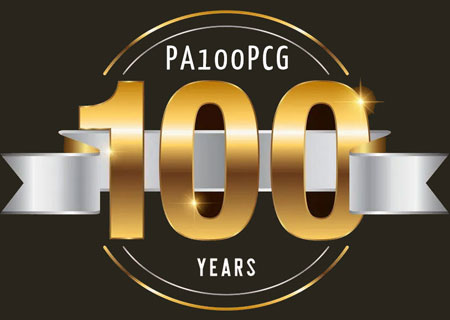
PA100PCG SES PA100PCG
Special event station honoring 100 years radiohistory. Active from the historical transmitter site at Kootwijk.

VRZA 100 years Malabar-Kootwijk
Activities executed by several VRZA branches related to 100 years radiohistory.

Heritageplatform Apeldoorn Erfgoedplatform Apeldoorn: 100 years Radio Kootwijk
Anniversary program 100 years Radio Kootwijk by the municipality of Apeldoorn.

Monument Radio Kootwijk Herstel monument te radio Kootwijk
Crowdfunding voor het terugbrengen van het Herinneringsmonument naar Radio Kootwijk.
Contact Us
You can reach us with the contactform
Find your directions: click here.
Address: Radioweg 11, NL-5844 AA Stevensbeek
If you want to contact us for whatever reason, please use the contactform below. Your message will be sent by e-mail to the PA100M/PA100K-team.
Your information will only be used to reply to you and will not be used for commercial purposes, nor shared with third parties.
 PA100M
PA100M



